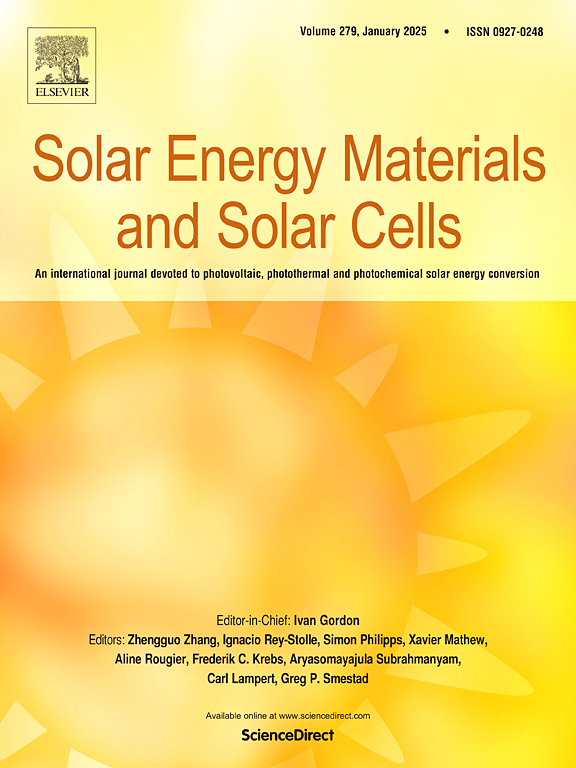Impact of phosphorus diffusion pre-gettering on the electrical properties of oxygen precipitates in n-type Czochralski silicon for heterojunction solar cells
IF 6.3
2区 材料科学
Q2 ENERGY & FUELS
引用次数: 0
Abstract
The pursuit of high-efficiency silicon heterojunction solar cells (SHJ) imposes stringent requirements on the quality of Czochralski silicon (Cz-Si) wafers. Phosphorus diffusion gettering (PDG) has been widely adopted as a standard process to remove metal impurities and improve minority carrier lifetime prior to SHJ fabrication. This study reveals a critical competitive interaction between oxygen-related defects and PDG effectiveness. Specifically, swirl-distributed oxygen precipitate nuclei greatly hinder the effectiveness of PDG, leading to an absolute efficiency loss of 0.4 % compared to the baseline power conversion efficiency (PCE) of about 25.11 % for efficient SHJ solar cells. Electron beam-induced current (EBIC) results imply that the residual iron impurities are located near the oxygen precipitates after a PDG process. Deep-level transient spectroscopy (DLTS) results further identify a deep level (Ec - 0.46 eV) associated with the interface states at the boundary of Fe-decorated oxygen precipitates and silicon matrix. This defect (Ec - 0.46 eV) persists after the PDG, indicating the limited effectiveness of PDG in eliminating iron impurities bound to oxygen precipitates. This work provides a deep insight into the competitive gettering mechanism for iron impurities between oxygen-related defects and PDG in n-type Cz-Si, which could be instructive to optimize wafers' quality for efficient SHJ solar cell manufacturing.
磷扩散预捕集对异质结太阳能电池n型直拉硅中氧沉淀物电性能的影响
对高效硅异质结太阳能电池(SHJ)的追求对奇克拉尔斯基硅(Cz-Si)晶圆的质量提出了严格的要求。磷扩散捕集(PDG)是制备SHJ前去除金属杂质和提高少数载流子寿命的标准工艺。这项研究揭示了氧相关缺陷和PDG有效性之间的关键竞争相互作用。具体来说,涡旋分布的氧沉淀核极大地阻碍了PDG的有效性,导致绝对效率损失0.4%,而高效SHJ太阳能电池的基准功率转换效率(PCE)约为25.11%。电子束感应电流(EBIC)结果表明,经过PDG工艺后,残余铁杂质位于氧沉淀附近。深能级瞬态光谱(deep -level transient spectroscopy, dlt)结果进一步确定了与fe修饰的氧沉淀和硅基体界面态相关的深能级(Ec - 0.46 eV)。这种缺陷(Ec - 0.46 eV)在PDG之后仍然存在,表明PDG在去除与氧沉淀结合的铁杂质方面的有效性有限。本研究深入揭示了氮型Cz-Si中氧相关缺陷与PDG对铁杂质的竞争捕集机制,对优化晶圆质量、高效制备SHJ太阳能电池具有指导意义。
本文章由计算机程序翻译,如有差异,请以英文原文为准。
求助全文
约1分钟内获得全文
求助全文
来源期刊

Solar Energy Materials and Solar Cells
工程技术-材料科学:综合
CiteScore
12.60
自引率
11.60%
发文量
513
审稿时长
47 days
期刊介绍:
Solar Energy Materials & Solar Cells is intended as a vehicle for the dissemination of research results on materials science and technology related to photovoltaic, photothermal and photoelectrochemical solar energy conversion. Materials science is taken in the broadest possible sense and encompasses physics, chemistry, optics, materials fabrication and analysis for all types of materials.
 求助内容:
求助内容: 应助结果提醒方式:
应助结果提醒方式:


